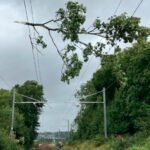Heavy rain and fierce thunderstorms brought Scotland to a standstill over the weekend, triggering major travel disruption, flooding risks, and growing concerns over passenger safety across rail, road, and air.
From midday Saturday to Monday morning, large parts of the country have been drenched with intense downpours. As emergency teams scramble and warnings stack up, daily life for many Scots has been turned upside down—again.
Yellow Warnings Blanket the Map
The UK Met Office issued multiple yellow weather warnings stretching from the Highlands to the Borders, kicking in from Saturday afternoon and sticking around through Monday.
Forecasters say some places could get 40mm of rain in just a couple of hours. On higher ground and southeastern slopes, that number could shoot up to 75mm—almost a month’s worth of rain in one go. That’s not just wet; it’s dangerous.
Flood alerts have followed swiftly. Surface water’s already rising in many parts, especially in low-lying areas. And with lightning crackling overhead and power lines taking hits, electricity outages aren’t just possible—they’re expected.

ScotRail Struggles to Keep Trains Running
It’s been a rough ride for ScotRail—and even rougher for passengers caught in the chaos.
Trains across the country are delayed, rerouted, or just not running at all. The network is under pressure, and there’s no clear end in sight until the storm system finally passes.
Some services are crawling along at reduced speeds to reduce the risk of derailments. Others have been cancelled altogether. Rail teams are on high alert, monitoring track conditions closely and ready to shut down sections if things get worse.
One short sentence to breathe.
A ScotRail spokesperson warned: “We’re asking customers to check before they travel. Real-time updates are available on our website and app.”
In other words—don’t assume your train’s running. It probably isn’t.
Roads Drenched and Dangerous
Scotland’s roads aren’t faring much better. Motorists are facing standing water, overflowing drains, and visibility so poor it’s like driving through soup.
Rural routes are particularly bad. Single-track roads, especially in the Highlands, are borderline unusable in places. Urban areas are dealing with similar issues, with some city center streets underwater by Sunday morning.
Here’s what drivers are being told:
-
Slow down—hydroplaning is a real threat.
-
Keep a safe distance—braking takes longer on wet surfaces.
-
Don’t drive through standing water—depth can be deceiving and deadly.
-
If possible, delay travel until conditions improve.
Local councils are also closing roads where needed, especially where drainage systems are overwhelmed or landslides are possible. It’s messy out there.
Buses, Ferries and Flights in the Mix
Buses aren’t escaping the mess. Intercity routes have seen long delays, and rural services are skipping stops or being rerouted entirely due to flooded roads. Commuters relying on bus timetables should expect a long wait—and possibly a no-show.
Ferry and flight operators are in standby mode. So far, there haven’t been widespread shutdowns. But weather-related delays are creeping in, especially on island routes and short-haul flights using smaller aircraft.
Storm winds are the wildcard here. If gusts pick up overnight into Monday, expect cancellations to rise fast.
Flood Alerts Trigger Precautions
The Scottish Environment Protection Agency (SEPA) hasn’t minced words: multiple flood alerts are active, and households should take early action.
They’re advising people to bring garden items indoors, move valuables upstairs, and pack emergency kits. That includes:
-
Torches with fresh batteries
-
Bottled water and long-life food
-
Portable phone chargers
-
Warm clothes and waterproofs
A single-sentence paragraph here.
SEPA says low-lying homes, especially near rivers, could see sudden water level rises.
Don’t wait until water’s coming through the door—act now.
Safety Warnings from Emergency Services
Emergency services across Scotland are urging the public to take the storm seriously. Thunder and lightning may look dramatic from the window, but being caught out in the open during a storm can be deadly.
The Scottish Fire and Rescue Service has asked people to avoid taking unnecessary risks. That includes walking or cycling near rivers, driving on minor flood-prone roads, or attempting to “see how bad it really is.”
One-line paragraph again.
“Don’t underestimate floodwater,” said a spokesperson. “It can knock you off your feet or trap your vehicle in seconds.”
Here’s a quick look at what different Scottish agencies are advising:
| Authority | Advice Issued |
|---|---|
| Met Office | Yellow rain and storm warnings through Monday |
| SEPA | Multiple flood alerts, especially south and west |
| ScotRail | Delays and cancellations—check before travel |
| Police Scotland | Avoid non-essential road travel |
| Fire Services | Stay indoors during active lightning periods |
That’s a lot of warnings—and with good reason.
Summer Storms Becoming the New Normal?
It’s not just a one-off anymore. Scotland’s seen a surge in summer storms over the past decade, with wetter, wilder weather becoming more frequent.
Climate experts point to shifting jet streams and warming sea temperatures as contributing factors. Thunderstorms that used to be rare in July are now regular, and each year seems to bring a record-breaking rainfall day.
In 2023, the Met Office recorded 27.7mm of rain in a single hour in Perthshire. This weekend’s storms are tracking along similar lines.
And yet, infrastructure hasn’t caught up. Urban drainage systems are strained. Railways flood. Roads collapse.
People are adapting—but slowly.


















